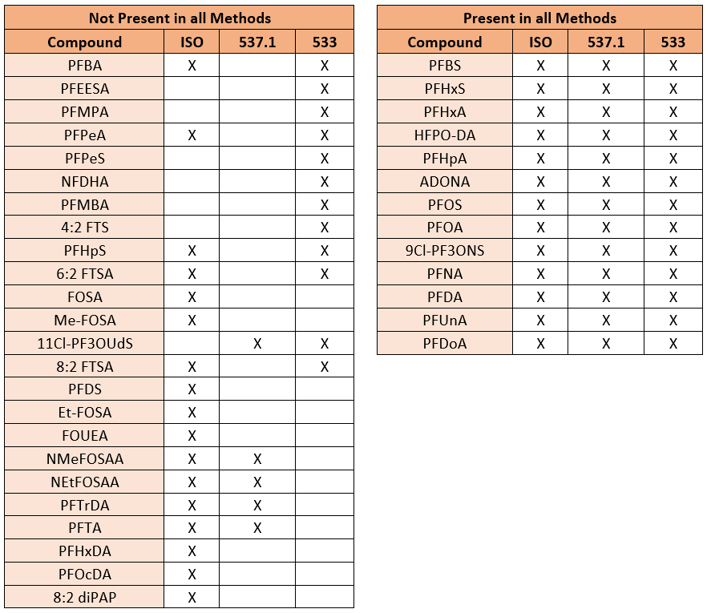Welcome to part 3 of our blog series “The Problem of PFAS”. If you are just tuning in, you might want to take a look at the previous blogs of this series as we provided background on the PFAS controversy (Part 1) as well as a review of the regulatory guidelines for monitoring PFAS contamination in the environment (Part 2). If you are up to speed on this series, you are now ready to dive deeper into the specific methods for monitoring PFAS in the environment.
US EPA Method 537.1 was one of the first methods developed to be used extensively to test PFAS during UCMR3 (Unregulated Contaminant Monitoring Rule 3). This method tests for a general array of 18 compounds identified as potential contaminants to drinking water. To keep it brief, styrene divinylbenzene (SDVB) media is used in combination with methanol to extract PFAS from a drinking water sample. The extract is then concentrated to dryness and reconstituted with 96:4 methanol:water. The non-selective nature of the Biotage ISOLUTE® 101 resin-based sorbent is ideal for the wider array of compounds that are screened during this method. You can even see the effectiveness of the ISOLUTE® 101 in our application note for EPA Method 537.1.
US EPA Method 533 on the other hand focuses more closely on short carbon chain PFAS specifically from C4 to C12, testing for a total of 25 compounds. A solution of methanol and ammonium hydroxide is used to extract these short chain PFAS from weak anion exchange (WAX) media, comprised of SDVB with a modified amino group. This method also concentrates to dryness but this time it is reconstituted with an 80:20 mix of methanol:water. Another feature of this method is the use of isotope dilutions to reduce matrix interference and improve data when analyzed. The Biotage EVOLUTE® WAX cartridge has been modified with amino groups to enhance the retention of the expanded list of targeted PFAS compounds seen in Method 533. If you’re interested in seeing the effectiveness of the EVOLUTE® WAX columns in extracting a select group of PFAS compounds, take a look at the following tech note.
Finally, the ISO 21675:2019 method is similar to Method 533 as it uses SDVB media with a modified amino group and utilizes a large array of isotope dilution standards to better identify the target analytes. The complete list tests for a total of 30 different compounds and includes a handful of unique analytes along with the familiar faces from EPA 537.1 and 533. As we had already discussed, the ISO method is more flexible since it’s not administered by a regulatory body, therefore limits are not dictated by the method. Also, unlike the other two methods we’ve highlighted, the ISO method can be used for sample matrices other than drinking water.
With that said, that brings us to the first huge indicators in what analytical method your lab should choose to monitor PFAS, will you be testing matrices other than drinking water? If your lab is monitoring PFAS in ground or wastewater, then ISO may be the method for you. If not, then you’ll have to dig into the alternative methods that the EPA prescribes for that particular matrix. After that, the driving force behind your decision should be based off the goals for your data and data quality objectives. The choice really depends on what regulations you need to meet, if any, and what target compounds you will need to test for. Using the table that we put together, you can easily see what compounds each of the three methods cover and decide based on that. EPA method 533 is even described as a compliment to method 537.1 meaning that they can be used in unison for the testing of 29 target PFAS compounds to further broaden your laboratory’s analytical options. Again, the real determining factor would be based on needs since they are all analyzed via LC-MS-MS so specific instrumentation would not be a concern.
There are always more PFAS compounds being discovered each day, so it is important to stay up to date with the regulations to ensure you have the right analytical method for your needs. In the next blog of this series, we will discuss the prevalence of PFAS contamination during the extraction process and how to tackle it.

Sources:
“EPA PFAS Drinking Water Laboratory Methods.” EPA, Environmental Protection Agency, 27 Apr. 2020, www.epa.gov/pfas/epa-pfas-drinking-water-laboratory-methods.
Visit our PFAS webpage for more information.

 Organic Workflow
Organic Workflow Peptide Workflow
Peptide Workflow Scale-Up Flash Purification
Scale-Up Flash Purification  Sample Preparation
Sample Preparation Biomolecule Purification
Biomolecule Purification Oligo synthesis
Oligo synthesis Scavengers and Reagents
Scavengers and Reagents Service & Support
Service & Support Accessories & Spare parts
Accessories & Spare parts Investors
Investors Reports & News
Reports & News The Share
The Share Corporate Governance
Corporate Governance Calendar
Calendar Sustainability
Sustainability Our Offering
Our Offering Our History
Our History Our Locations
Our Locations Leadership
Leadership